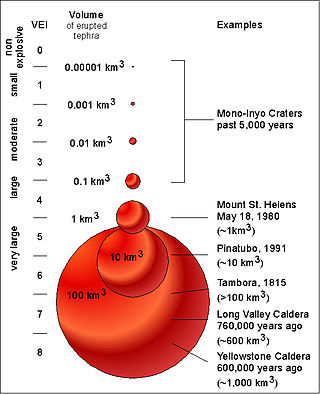Volcanic Explosivity Index
relative measure of explosive volcanic eruption size (based on product volume, eruption cloud height, etc.), open-ended with the biggest prehistoric eruptions given magnitude 8 From Wikipedia, the free encyclopedia
Remove ads
In volcanology, the Volcanic Explosivity Index (VEI) is the way to measure the strength of a volcanic eruption. The Volcanic Explosivity Index measures how large or strong volcanic eruptions are. The index is a scale of 0 to 8. 0 is very small, and 8 is huge and very rare.

The largest eruption in modern times, the 1980 eruption of Mount St. Helens, was a 5 on the index. The Oruanui eruption of the Taupo Volcano in New Zealand was the world’s largest known eruption in the past 70,000 years was an 8. Another eruption of the Taupo volcano happened about 1,800 years ago. It was the most violent eruption in the world in the last 5,000 years. Mt Tambora was a 7 on the Volcanic Explosivity Index. Supervolcanoes have a Volcanic Explosivity Index of 8; and if the definition is expanded, also include volcanoes with a Volcanic Explosivity Index of 7.
About 40 eruptions of VEI-8 magnitude within the last 132 million years (Mya) have been identified, of which 30 occurred in the past 36 million years. Considering the estimated frequency is on the order of once in 50,000 years,[2] there are likely many such eruptions in the last 132 Mya that are not yet known. Based on incomplete statistics, other authors assume that at least 60 VEI-8 eruptions have been identified.[4][5] The most recent is Lake Taupō's Oruanui eruption, more than 27,000 years ago, which means that there have not been any Holocene eruptions with a VEI of 8.[4]
Remove ads
References
Further reading
Other websites
Wikiwand - on
Seamless Wikipedia browsing. On steroids.
Remove ads
